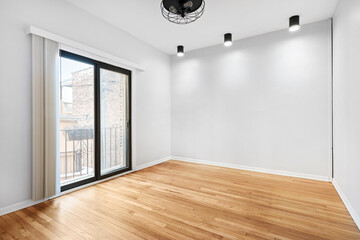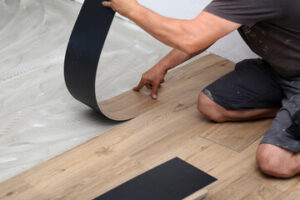Hardwood floors add beauty, warmth, and value to any home. But they also come with their own challenges, from choosing the right wood species to ensuring it is installed properly. Some homeowners are tempted to DIY the installation process, but it is best left to the pros. They will guide you through the entire process, from buying to finishing your hardwood floor.

If you want to make your home feel more inviting, you can’t go wrong with hardwood floors. The natural material brings a sense of warmth and balance to the space, making it one of the most popular design trends in residential architecture today.
Whether you’re installing wood, laminate or another type of flooring, preparing the space before the installation begins is important. This will ensure a smooth, problem-free finish and help you get the most out of your new floor.
Before you begin, clear out furniture, wall base, trim and shoe molding so that the wood planks can be nailed, stapled or glued down without obstruction. The goal is to make sure you can install the wood planks as closely to the walls as possible, creating a seamless look.
Once the space is cleared out, you can start to plan out how you’ll install your new hardwood floor. Decide if you’ll do the installation yourself, hire a professional or have an experienced contractor work for you.
It’s also a good idea to consult with a sub-floor expert, as a poorly prepared or contaminated subfloor can cause problems for your new hardwood. The subfloor should be sanded to a flat, level surface and any stains or oils should be removed. If you’re putting the hardwood over concrete, or in a high-humidity or damp environment, a moisture barrier should be installed to prevent water from seeping up through the subfloor.
When you’re ready to sand the subfloor, use a sander (or a scraper) to rid the surface of paint, oil, wax or adhesives that may be present. Then, test the subfloor for moisture using a moisture meter that is calibrated for the type of flooring you’re installing.
If you’re putting the wood over existing plywood, put down a layer of 6-mil moisture barrier underlayment to prevent water from wicking up through the subfloor and seeping into the hardwood. If you’re gluing the wood to concrete, a trowel-applied vapor barrier will also protect it from water.
When it comes time to install the wood, be sure to follow all of the instructions on your specific flooring product. Some solid or engineered wood products must be nailed, stapled or layered, and some can be floated. These methods vary slightly, but the general principles are the same: prep the subfloor, lay your floor and finish it.
Installing hardwood floors can give any room a fresh look and a new sense of style. They’re also a solid investment that will increase your home’s resale value.
Installation is a complicated process, so you might want to hire a professional. They can help you choose the right flooring for your needs, prepare your floor and install it. They can also handle the finishing, sanding and other steps necessary to make your new flooring look great.
A professional can also help you decide on the best trim for your floors, such as reducers, t-molding or quarter rounds. They can also help you determine the best direction to lay your hardwood flooring, so it will blend in with your room’s layout.
If your wood planks aren’t straight, they can sag and buckle or separate from one another, so it’s important to lay them perpendicular to the floor joists. This prevents this from happening and can help your floor look more even.
Before you begin, clear out furniture and any other items that will be in the way of the installation process. Then, prepare the subfloor by cutting it if needed and installing an underlayment. You can buy this in many different forms, including foam, plywood or tile.
When the subfloor is ready, you’ll need to measure and cut your wood boards to size. You’ll need to leave a certain amount of space around the perimeter of your room, as well as around doorways and other obstructions. This extra space allows for the expansion and contraction that happens as the weather changes.
You’ll also need to acclimate the wood before it’s installed. This gives it a chance to adjust to the room’s temperature and moisture levels, which can help prevent your floors from sagging or buckling.
The acclimating process takes about five days. You can’t install your flooring until it’s had this time to settle and become accustomed to the room’s atmosphere.
The next step is to spread the boards across the floor, making sure you’re racking them in the correct direction and keeping the end joints properly spaced. This is the process that pros call “spreading,” and it will ensure your floors are evenly laid.
Hardwood floors are a beautiful addition to your home, but they also require a little extra maintenance and care to keep them looking great. As with most surfaces, hardwood floors are susceptible to dirt, dust and grime that can take away from their charm. This is especially true when you have hardwood flooring installed in high-traffic areas such as stair landings, hallways and living rooms.
Regular sweeping, vacuuming and dust mopping of your new floors is the best way to remove this buildup. However, be sure to use a dust mop that is designed specifically for wood floors. These mops use synthetic microfiber strands that create a static charge, attracting dirt and dust to the fibers and removing them from your floors.
Besides reducing the amount of dirt, dust and pet dander that accumulates on your floors, sweeping and vacuuming will help to prevent scratches and dents from falling onto the floor. It will also minimize the buildup of grit and sand that can leave your floors looking dull and old.
Another important part of routine wood floor maintenance is to protect your floors from exposure to natural and artificial sunlight. Even if you have LIFECORE UV finishes, exposure to the sun’s harmful rays can cause your floors to fade or soften their color to varying degrees.
If your floors start to show signs of fading, you may need to have them refinished. If the damage is minor, you can often repair it by applying finishing putty that is available in blending colors.
In the case of major damage, you will likely need to replace your boards. Consult with a certified hardwood flooring expert to determine what needs to be done.
Furniture pads are a great way to protect your floors from scratches and dents caused by the legs of chairs and other furniture. These pads are usually installed at the time of your hardwood floor installation and should be kept in good condition.
Depending on your lifestyle, you may need to deep clean your floors once or twice a year. If you have pets or kids, you may want to deep clean more frequently, but either way, keeping up with the cleaning will help you maintain your floors for many years.
Hardwood floors add a natural touch to any home. They provide an inviting atmosphere, and they can also increase your property’s resale value. However, like any flooring material, hardwood floors can be damaged and need repair.
Luckily, most hardwood flooring problems are minor and can be fixed at home. It is best to repair dents, scratches and cracks before they become too severe.
Scratches can occur from everyday use, pet fur, furniture and furniture pads, and dragging appliances over the floor. While they can be difficult to fix, a little sanding and staining will usually do the trick.
Another common problem with hardwood floors is squeaks and gaps between planks. Fortunately, these can often be fixed by replacing the damaged board and installing new ones.
If squeaks are caused by moisture, remove the affected boards and allow them to dry. This will stop the problem before it reaches more serious levels and may avoid having to replace entire sections of the wood.
For more extensive damage, such as rotted wood, termite infestation or water damage, replacement is the only option. If you have to replace a wood floor, it’s best to choose a new material based on your budget and the structural integrity of the subfloor.
One of the most important factors to consider when deciding on a new wood floor is its hardness. Some hardwoods, such as hickory, maple, oak and ash, are very durable and resistant to impact damage, denting and heavy-traffic wear.
But some hardwoods, such as birch, pine and black cherry, are not quite as tough. They do not last as long and will not boost the resale value of your home as much.
In these cases, you should consider engineered hardwood flooring or laminate wood floors. They offer the same look as natural hardwood floors without the high price tag and they are also very durable.
If you’re interested in adding a new hardwood floor to your home, be sure to ask about warranties before making the decision. It’s also a good idea to have the work done by a professional to ensure it is installed correctly.

